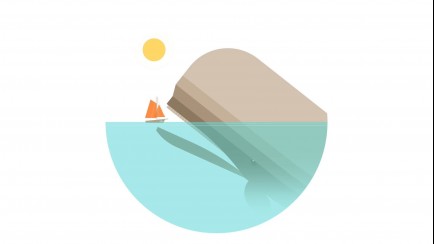
For one, you have to repeat a lot of the early content to get back to a later split. This format does have its drawbacks, of course. Their locations on the map don't seem to matter. The four icons surrounding the central island represent my choices, in this case: the initial whale encounter, a meeting with a colossal rock golem, running afoul of an underwater predator whose enormous jaws are its only visible feature, and the enigmatic and squiggly sea dragon. If the game has anything close to puzzles, it's in the decisions themselves and identifying where the branch may lie: did you try scrolling to the left or the right last time? If you're being antagonised by a monstrous sea creature, what happens if you let it win? The end "results screen," which simply involves the brothers reading their now completed sea chart before adding it to the coffee shop's bookcase and grabbing a fresh one, gives you some idea of where you had a choice to make. The game uses this foreknowledge to, in effect, remind players of the paths already travelled (through new dialogue) so they might try something different on the next attempt. A different set of responses the following day results in a new adventure with new events, though the sequential nature of the game means the brothers and the NPCs they meet are always cognizant of what has already transpired in an earlier loop.


To save you some mental math, that's a total of twelve possible endings (1-1-1, 1-1-2, 1-2-1, 1-2-2, 2-1-1, and so on). The game is designed as such so that the whale can be escaped in one of three ways, and each of those three ways then leads to a binary choice, followed by another, after which the trio converse with an enigmatic sea dragon who drops them back off on their home island just as the new day dawns.
#Burly men at sea videogame how to
So begins their latest story, the opening vignette of figuring out how to escape the whale triggering a series of events determined by the player's previous responses. The confused fishermen set out onto the open sea, only for their boat to be consumed by a monstrous whale. The chart itself is empty, but as a local elderly barista tells the trio the idea is that the chart itself invites adventure and fills itself out at the end of the journey. A popular route, as it were, is the "choose your own adventure" hook of having multiple paths to select between: the player is given agency when a branch in the road is presented, with their choices affecting the rest of the playthrough by a significant (entire new destination) or subtle ("so-and-so will remember what you did") degree.īurly Men at Sea follows a vaguely The Odyssey-esque nautical shaggy dog tale of three mostly identical bearded fishermen brothers who fish up a sea chart in a bottle one day.

In particular those that are better served with the interactivity that video games bring, if not necessarily with the same reflex-intensive focus that an action game might have. One of the threads I keep returning to with the Indie Game of the Week feature, mostly incidentally, is how Indie adventure games are always experimenting with storytelling techniques.


 0 kommentar(er)
0 kommentar(er)
